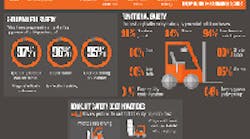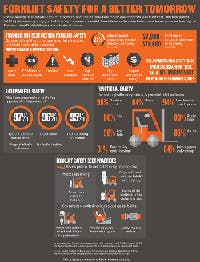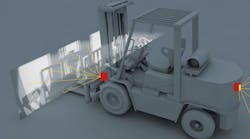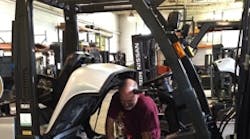Most of the material handling and logistics innovations exhibited at this week’s ProMat Expo in Chicago’s McCormick Place could be described as “enabling” technologies. But if you wanted to hear about disruptive technologies you had to talk to the people staffing the displays. They’re the ones who tell you the rest of the story, or, “where do we go from here?”
I had a few of those discussions both on and off the show floor. One of the more memorable was with Rich Sherman, author and director of strategic development for the Council of Supply Chain Management Professionals. He believes one of the more disruptive technologies will make its way from retail stores and gaming arcades and into our warehouses. It will combine optical imaging capture with automated search and storage capabilities. Say goodbye to lift truck operators and hello to forklift “gamers.” Operators will control lift trucks remotely and use image capture to find and pick orders. Imagine the drones you’ve read about that are changing modern warfare and you have an idea of what he’s talking about. Far out? If anything, it could get the attention of young xBox whizzes and convince them that logistics might be a cool career.
Until that happens, let’s turn our focus back to making whizzes of our existing warehouse workers. The forklift leaders working the ProMat floor were all about that. At the Raymond exhibit I had a chat with one of that OEM’s customers, Bob Simon, senior director of contract packaging at Genco, the third party logistics service provider. He told me about his company’s new partnership with Raymond and with Easy Metrics, a labor management system provider. The goal of this relationship is to reduce costs and increase worker productivity. Genco uses Raymond’s iWarehouse fleet optimization system. This combination helps Genco ensure that only trained personnel are using the equipment and at what level of productivity. It also helps the operators understand their productivity and gives them an incentive to improve.
Simon also explained that this system offers visibility to fleet utilization. For example, Genco eventually learned that 60% of their picks were being executed by high-reach trucks vs. the walkie-riders that were more appropriate for the task. By gaining visibility to this issue, it helped Genco’s employees go from working at 62% of work standards to 93%. In addition, Genco avoids having to swap out equipment as frequently and gets better performance from its assets.
Coincidntally, later that day I had a similar conversation with Jim Gaskell, director of global insite products for Crown Equipment. Crown wasn’t exhibiting but they were working the show just the same—networking and learning. Jim said that many fleet managers have an inaccurate bead on their targeted performance goals. According to his company’s research, many customers think they’re getting as much as 80% utilization of their fleets. Gaskell says it’s more like 40-60%. The problem, he told me, has to do with a combination of warehouse design and activity spikes. The remedy might be as simple as changing the work flow through the facility and paying more attention to what the operators are doing. That can be done more easily with the help of telematic fleet tracking.
In an off-floor meeting with Jeff Rufener, president of Toyota Material Handling, who was attending the show with members of his quality assurance and engineering staff, I was reminded that safety goes hand-in-hand with productivity. We chatted about many things, but one key takeaway in light of this particular blog post is the fact that, as Toyota reminds all of its customers, proper lift truck operator training can lead to a 61% improvement in operator performance scores. When you consider that a quarter of lift truck accidents are the result of inadequate training and that OSHA fines for this inadequacy can reach $70,000, it’s clear that the most important aspects of lift truck ownership are the simplest to understand and the easiest to apply. The hardest part is making the time to tour what’s going on under your own roof. You won’t get that kind of visibility from a drone. Shoe leather is still a better investment.






